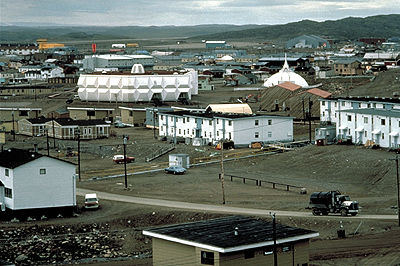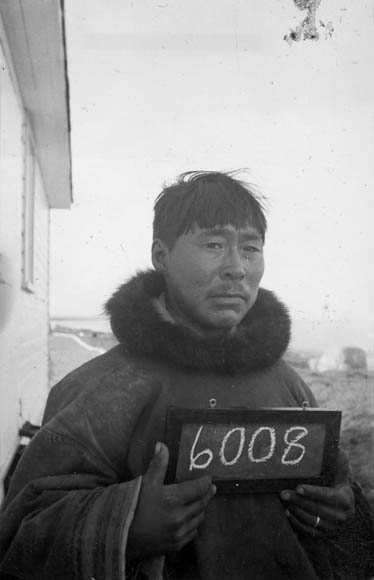The Indigenous population is the most rural in Canada. According to the 2021 census, 1.8 million people claimed to be of Indigenous ancestry, and 801,045 Indigenous people lived in urban centres in Canada.

Redefinitions of Life
The market system and other features of Canadian culture have penetrated most Indigenous communities. In some instances, the traditional sustenance way of life is viewed as unable to provide the necessities of life. Thus, with the added factors of an increase in the Indigenous population and the depletion of game in some areas, people leave hunting, fishing and fur trapping to move to urban centres.
A semiurban life in large villages was common among the Huron-Wendat and Haudenosaunee in the east and the coastal Salish, Nuu-chah-nulth, Kwakiutl and Tsimshian in British Columbia. According to the 1996 Indian Register, 42 per cent of people with registered Indian Status lived off-reserve. The population of First Nations has become urbanized because they are located adjacent to or within urban centres.
According to the 1991 Aboriginal People's Survey, the percentage of adults who reported having changed communities at least once in their lifetime was 22 per cent in Ontario, 21 per cent in British Columbia, 14 per cent in the Prairies, 9 per cent in Québec, 8 per cent in the Maritimes and 2 per cent in the North. Thus, the level of off-reserve migration is high in Ontario and British Columbia, moderate in the Prairies and low in Québec, the Maritimes and the North. The high rates of migration have come from the First Nations that are smaller in size, have a tradition of working off-reserve and have limited on-reserve opportunities, higher education levels, and more integrated schools.
Analysis of Indigenous Migration
Specific data on rural to urban migration are generally lacking for the Indigenous population, and most of the available information on their mobility patterns is based on census data. In a 1986 census analysis of Indigenous migration, it was discovered that people with Indian Status who have lived off-reserve had a greater propensity to change communities than the Indigenous population who lived on-reserve. First Nations peoples and Métis people had higher levels of off-reserve migration.
According to the 1991 Aboriginal People's Survey, the proportion of adults who had ever moved sometime in their lifetime but not in the last 12 months was 61 per cent for First Nations people currently living either on- or off-reserve or on settlements; this was 69 per cent for Métis people. Of those who had ever moved, 41 per cent of First Nations people and 48 per cent of Métis people reported that they had moved to their current residence from somewhere else in the same community, and 27 per cent of First Nations people and 26 per cent of Métis people had moved to their current locality from a different community within Canada.
In the Aboriginal People's Survey, there were 40,330 Status Indians and 14,590 Métis people who reported at least one move within the last 12 months. Of these individuals, 22 per cent of Status Indians and 17 per cent of Métis people had moved from a different community within Canada.
Inuit are more isolated from the major urban centres than First Nations and Métis. They continue to participate in a sustenance way of life. It is not surprising, then, that they are less likely to be drawn to the city. In the Aboriginal People's Survey of 1991, there were 3,445 adult Inuit who moved during the 12 months prior to the survey. For those who moved within this time period, 29 per cent moved from a different neighbourhood but the same community and only 11 per cent moved from a different community within Canada.
Off-Reserve Growth Rates
The implementation of Bill C-31 in 1985 contributed to the high growth rate of the off-reserve population since 1985, as many Indigenous people residing in off-reserve areas who had lost their Indian Status could reclaim their ancestry. In 1985, a potential 76,000 women and their children who lost Indian Status through marriage were eligible for reinstatement under the provisions of Bill C-31. As a result, over 100,000 people have been added to the Registered Indian population. According to the 1996 Indian Register, the off-reserve population increased from 147,424 in 1987 to 256,505 in 1996.
The expansion of medical, educational, housing and business services on reserves has supported the desire to maintain at least a nominal residence on a reserve. Many of these people are also trying to be accepted by their First Nations and to re-establish residences on-reserve. According to the 1991 Aboriginal People's Survey, the number of Indigenous adults who had ever changed residence increased from 40,020 between 1981 and 1985 to 140,300 between 1986 and 1990. It is likely that a significant proportion of the people represented in the latter time-frame were involved in return migration to a reserve.
In moving off-reserve, Indigenous people leave the jurisdiction where services are supported primarily by Indigenous Services Canada (ISC) and move into the jurisdiction of dozens of other federal and provincial agencies (see also Federal Departments of Indigenous and Northern Affairs). Hence, Indigenous people who migrate to urban areas must rely on provincial and municipal governments for public services. According to the Royal Commission on Aboriginal Peoples (1996), in 1991 the federal government provided provincial governments over $70 billion to fund Indigenous programs in the areas of post-secondary education, health and the Canada Assistance Plan. The Secretary of State, in particular, funds off-reserve Indigenous programs, providing several million dollars annually to support Indigenous political associations, urban Indigenous Friendship Centres across the country, women's associations, and social and cultural associations. The urban Indigenous centres provide valuable social functions and help to integrate the diverse social services available to Indigenous people in cities. Winnipeg has the largest number of Indigenous people living in an urban area, with the 2021 census indicating over 102,000 Indigenous people live in the city.
The Report of the National Round Table on Aboriginal Urban Issues (1993) focused on the concerns and issues that confront Indigenous people who migrate to urban areas. It recommended the following key service areas that would address some of the concerns of the Indigenous urban population: education, addictions, disability, AIDS, homelessness, child welfare, social services, health, employment and housing, cultural awareness/isolation and street youth (see Education of Indigenous Peoples in Canada; Health of Indigenous Peoples in Canada; Social Conditions of Indigenous Peoples in Canada). It also stressed that culturally appropriate services must be adapted to the lifestyles and the customs of Indigenous individuals and communities.
Urban Indigenous Institutions
The development of urban Indigenous institutions (Québec has a unique, more assimilating, urban pattern) can generally be identified in four categories: social services provided by the mainstream community; popular family-oriented kinship-friendship networks as Indigenous people themselves take over social services such as court work, support for addictive behaviours and social work as needed; an elaboration of artistic, educational, political, recreational and religious voluntary associations; and the development of academic and professional services by Indigenous people. More importantly, cultural creativity can be seen in the new kind of Indigenous societies that are developing in urban Canada.
Mobility characterizes Indigenous women more often than men and is noticeable in small northern communities. More young Indigenous women migrate to urban centres than do men. Indigenous women tend to go further in school and take lower-paying but steadier jobs than men and make up 54 per cent of the urban Indigenous migrants nationally. A 1978 survey by the Ontario Native Women's Association of 1,094 Indigenous women showed only slight differences in the activities and attitudes of the women who lived on- and those who lived off-reserve. Most off-reserve Indigenous people lived in towns and the smaller range of cities and continued to maintain strong kinship and friendship ties with those who lived on-reserve (see Indigenous Women’s Issues in Canada).
Adaptations
Studies across the country show that housing shortages, increased population and the lack of jobs on the reserves are the most common reasons why Indigenous people migrate to urban areas when they are young. Successful urban adaptations are related to several factors: the cultural background of individuals according to the traditional evolutionary level of their Indigenous social heritage; historical elements such as the length and intensity of non-Indigenous contact; the urban proximity of their communities; the local quality of receptivity such as the extent of anti-Indigenous prejudice and discrimination; and the extent of involvement of urban Indigenous institutions in the city to which they move.
A regional ranking of successful urban adaptations starts high with Québec, where few Indigenous people leave reserves but are relatively well received when they do move; next are southern Ontario, southern Alberta and Vancouver; then British Columbia, Yukon, the Northwest Territories and the Maritimes; and finally, northern Alberta, Saskatchewan, Manitoba and northern Ontario, which have the poorest urban adaptations because of widespread racism, low urban proximity and relatively limited urban Indigenous group institutions.
Urbanization across the Arctic, from Siberia to Greenland, has been a process of concentration from hundreds of very small seminomadic Indigenous hunting groups into dozens of permanent villages and a few large communities such as Inuvik and Iqaluit. Since Inuit and other elements of the population must live co-operatively in the same communities, people get to know each other and there is less prejudice and discrimination than in the northern part of the Prairie provinces, where First Nations people and Métis people tend to live on-reserve or in other communities segregated from the non-Indigenous population. In the Arctic, where there is a high turnover of workers in boom-town conditions, social problems tend to develop more within these large towns, as at Tuktoyaktuk, the base for oil exploration in the Beaufort Sea.

 Share on Facebook
Share on Facebook Share on X
Share on X Share by Email
Share by Email Share on Google Classroom
Share on Google Classroom


